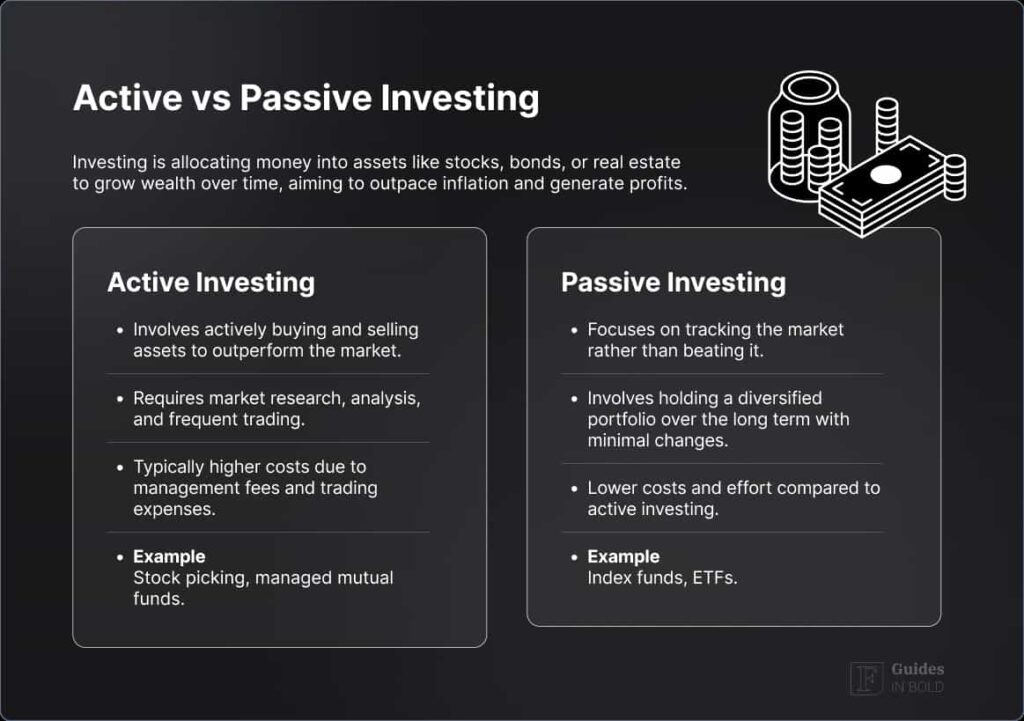While $500 may not feel like a fortune, through smart investments, it can definitely be used to kickstart one. In this guide, you will learn how to invest $500 in 3 different ways, along with the pros and cons of those approaches as well as what to consider before you start investing.
Highly Rated Stock Trading & Investing Platform
-
Invest in stocks, ETFs, options and crypto
-
Copy top-performing crypto-traders in real time, automatically.
-
0% commission on buying stocks - buy in bulk or just a fraction from as little as $10. Other fees apply. For more information, visit etoro.com/trading/fees.
-
eToro USA is registered with FINRA for securities trading.
What kind of investor are you?
Before you decide how to invest $500, answer these questions:
- What is your investing goal? Is it to save for an upcoming expense, such as a car or a down payment for a house, or are you saving for retirement? This is important because a short-term goal will demand a distinctly different approach to a long-term one;
- What is your risk tolerance? Investing is risky, and how you distribute your assets will depend on your risk tolerance;
- How much do you want to be involved? Are you an active or passive investor? Assuming that you prioritize long-term gains instead of seeking short-term profits, both methods can be beneficial. Nevertheless, we advise beginners to adopt passive strategies instead of attempting to outperform the market. Moreover, if you’re new to investing, financial advisory services could be helpful.

Before proceeding further
Best ways to invest $500
Congratulations, you have an additional $500 at your disposal. But, rather than spending it, why not put the money to work, and use this opportunity to embark on your investment journey?
Depending on how you want to invest, $500 is plenty to get started with. And there is a plethora of investment options available to you. But ultimately, the ideal approach to investing $500 is to select the financial instrument(s) that cater to your unique requirements to help you attain your future financial objectives.
This is our pick for the three best ways to invest $500:
- Buying fractional shares;
- Index investing;
- Real estate — REITs.
Let’s now take a closer look at these methods.
1. Buying fractional shares
In this section: How to invest $500 in the stock market?
Investment type: Long-term growth
Risk Level: Varies
Broker to consider: Regulated, secure platform eToro.
Highly Rated Stock Trading & Investing Platform
-
Invest in stocks, ETFs, options and crypto
-
Copy top-performing crypto-traders in real time, automatically.
-
0% commission on buying stocks - buy in bulk or just a fraction from as little as $10. Other fees apply. For more information, visit etoro.com/trading/fees.
-
eToro USA is registered with FINRA for securities trading.
Over several decades, disciplined investing in the stock market is generally the most effective approach to building long-term wealth. Although returns may vary year-to-year, consistently reinvesting your profits will lead to compound gains, causing your original investment to grow even more over time.
One approach to getting into the market with limited capital involves buying fractional shares. As their name suggests, a fractional share is a portion of stock smaller than the whole share. Fractional shares allow you to invest by the dollar amount and are a low-cost way of diversifying your portfolio by investing in companies that otherwise might be out of reach.
Then, once you know which stocks you’re interested in buying, you can shop for an investing platform. Most online brokerages, such as eToro or Interactive Brokers, offer fractional shares as well as commission-free trading, meaning you will not pay transaction fees associated with purchasing or selling your partial shares.
However, for those who need more assistance, opening an account through a robo-advisor will be the more convenient option.
Dividend Investing
Pros and cons of investing in the stock market

Pros
- Grow with the economy;
- Stay ahead of inflation;
- High liquidity;
- Low barrier of entry;
- Income from price appreciation as well as dividend payments;
- Online brokers make access to the stock market easy and inexpensive.

Cons
- Risky;
- Generating profits generally takes decades;
- Volatility;
- Putting together a well-diversified portfolio can be highly time-consuming, requiring constant research, news tracking, and adjustment.
Note
2. Index investing
In this section: How to invest $500 in index funds such as the S&P 500?
Investment type: Long-term growth
Risk Level: Varies
Broker to consider: Regulated, industry-leading low-cost trading platform Interactive Brokers.
Best Platform for Worldwide Stock Trading & Investing
-
Highly trusted multi-asset broker with clients in over 200 countries
-
Trade on 150 markets globally from a single platform (stocks, ETFs, futures, currencies, crypto & more)
-
Low commissions starting at $0 with no platform fees or account minimums
-
Easily fund your account and trade assets in 26 currencies
-
IBKR pays up to 4.58% interest on cash balances of $10k or more
Index investing is a passive investing strategy in which investors purchase exchange-traded funds (ETFs) or mutual funds that track major market indexes and hold them over a long time. This technique aims to match, not beat, the performance of the market benchmark.
Passive management is the opposite of active management, in which a fund’s manager selects the securities to include in a portfolio in an attempt to beat the market. As a result, passively-managed funds tend to charge lower fees to investors than actively managed funds, such as the S&P 500.
The three most widely tracked indexes in the US are:
- The S&P 500;
- Dow Jones Industrial Average;
- Nasdaq Composite.
Pros and cons of investing in index funds and ETFs

Pros
- Low cost;
- Ready-diversified;
- High liquidity;
- No active management;
- Stable long-term returns;
- Reduced volatility.

Cons
- Follow the index even in poor market conditions;
- Lack of exposure to mid-and small-cap companies;
- No short-term gains;
- Dividend yields may be lower than owning a high-yielding dividend stock or group of stocks.
Note
3. Real Estate – REITs
In this section: How to invest $500 in real estate?
Investment type: Long-term growth and diversification
Risk Level: Medium
Broker to consider Regulated multi-asset investing platform eToro.
We’ve covered the stock market. Now let’s see how you can invest $500 in real estate.
Needless to say, $500 is not enough for a down payment for an investment property. However, it is enough to get exposure to real estate if you consider investing in REITs.
REITs are publicly-traded companies that own, operate, or finance income-generating real estate. REITs (as well as REIT mutual funds and REIT ETFs) can be bought or sold via a brokerage account, making them the most liquid real estate investment out there.
Note
Pros and cons of investing in REITs

Pros
- Some of the beefiest dividend yields on the market;
- Takes the manual work out of owning real estate;
- Returns over the past 20 years have surpassed the S&P 500;
- Highly liquid (unlike physical real estate investments);
- A ready-diversified real estate portfolio for any budget.

Cons
- Because 90% of a REITs taxable income is paid out as dividends, only 10% gets reinvested into the REIT, resulting in slow growth;
- Dividends are taxed as regular income;
- Hypersensitive to interest rates.
How to safely invest $500 — things to consider
Although you may be eager to start investing your $500, you should first evaluate your overall financial position and ensure that you have fulfilled the following:
- High-interest debt is dealt with: Prioritize repaying any high-interest debt, such as credit card debt or payday loans, before you embark on your investment journey. Keep in mind that the average credit card interest rate is 19.42% (in 2022), which is considerably higher than the average annual stock market return, and can consequently cancel out any gains you may make investing in stocks. Low-interest debts like mortgages or auto loans, on the other hand, do not need to be repaid before you start investing;
- You have an emergency fund set up: Create an emergency fund to cover unforeseen expenses, such as medical bills, car repairs, or job loss, before you start investing. A general guideline for most individuals is to set aside six months’ worth of living expenses in a deposit account like a savings or money market account, where the principal is not at risk. It is worth noting that having this money readily available will also help you avoid dipping into your portfolio, using high-interest credit cards, or resorting to loans.
Then, as you begin your investment journey, make sure to:
- Diversify: To spread your risk and protect yourself from significant losses, distribute your investments across different financial instruments, industries, and categories. Moreover, a diversified asset allocation is vital in determining whether you will achieve your financial objective. For instance, if your portfolio does not carry enough risk, your investments may not generate a sufficient return to reach your goal;
- Spread out your investments: After investing the $500, keep investing. We suggest adopting a dollar-cost averaging (DCA) strategy, which involves dividing the total investment amount into regular purchases over a specific period (e.g., investing $100 monthly in an index fund regardless of market fluctuations). By spreading out your investments in this manner, you can minimize the impact of price volatility and reduce the average cost per share;
- Stay wary of fraud: Scams are getting increasingly sophisticated. Moreover, con artists are often highly articulate, charming, and knowledgeable, with credible websites, testimonials, and documents that are difficult to distinguish from genuine ones. However, the old adage holds true in this case: if something sounds too good to be true, it probably is. Therefore, ensure you thoroughly understand the investment before entrusting someone with your funds. Begin by searching for the company’s financial statements on the Securities and Exchange Commission’s (SEC’s) EDGAR filing system. You can also refer to the Financial Conduct Authority’s (FCA) list of warning signs here and the SEC’s list of questions to ask about your investments to ensure their legitimacy here.
Highly Rated Stock Trading & Investing Platform
-
Invest in stocks, ETFs, options and crypto
-
Copy top-performing crypto-traders in real time, automatically.
-
0% commission on buying stocks - buy in bulk or just a fraction from as little as $10. Other fees apply. For more information, visit etoro.com/trading/fees.
-
eToro USA is registered with FINRA for securities trading.
Conclusion
Not only is $500 enough to start building wealth meaningfully but starting small can also instill constructive investing habits that will help you reach your future financial goals.
With patience, discipline, and a long-term perspective, your $500 investment may grow tenfold, and it won’t be long until you find yourself researching how to invest $5k, $10k, and eventually even $100k.
Disclaimer: The content on this site should not be considered investment advice. Investing is speculative. When investing, your capital is at risk.
FAQs about how to invest $500
How to invest $500?
Invest your $500 in a diversified portfolio of stocks and index funds. This helps to spread out your risk and minimize losses. You can invest the $500 as a lump sum, after which you can add onto your investment by dollar-cost averaging. However, remember to settle any high-interest debt before investing.
How to invest $500 in the S&P 500 index?
You can invest $500 in the S&P 500 by buying shares of a mutual fund or exchange-traded fund that tracks the index.
Where to invest $500 right now?
Where you invest your $500 will be influenced by factors such as your age, investment time horizon, risk tolerance, and financial goals. Nonetheless, a diversified investment portfolio that comprises multiple asset classes with varying levels of risk is recommended.
Is 500 dollars enough as an investment?
You can certainly start investing with just $500. However, your options will be more limited, so you will have to do a lot of research to see what kind of approach suits you the most.
Highly Rated Stock Trading & Investing Platform
-
Invest in stocks, ETFs, options and crypto
-
Copy top-performing crypto-traders in real time, automatically.
-
0% commission on buying stocks - buy in bulk or just a fraction from as little as $10. Other fees apply. For more information, visit etoro.com/trading/fees.
-
eToro USA is registered with FINRA for securities trading.





